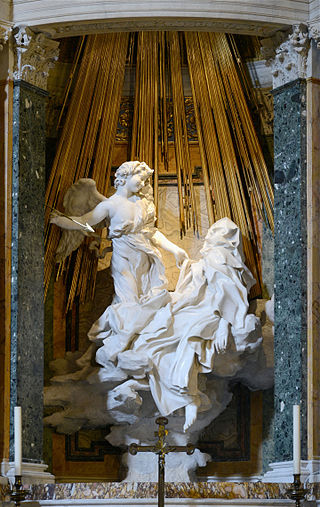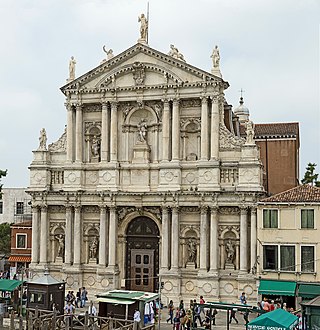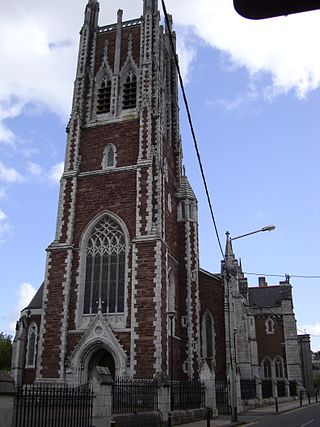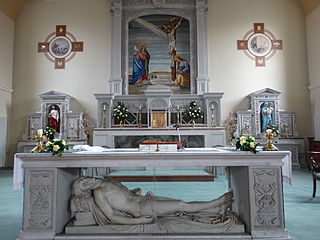
John of the Cross, OCD was a Spanish Catholic priest, mystic, and Carmelite friar of converso origin. He is a major figure of the Counter-Reformation in Spain, and he is one of the thirty-seven Doctors of the Church.

St Mary's Church, known also as St Mary's Pro-Cathedral or simply the Pro-Cathedral, the Chapel in Marlborough Street or the Pro, is a pro-cathedral and is the episcopal seat of the Roman Catholic Archbishop of Dublin and Primate of Ireland.

Roscrea is a market town in County Tipperary, Ireland, which in 2016 had a population of 5,446. Roscrea is one of the oldest towns in Ireland, having developed around the 7th century monastery of Saint Crónán of Roscrea, parts of which remain preserved today.

Kanturk is a town in the north west of County Cork, Ireland. It is situated at the confluence of the Allua (Allow) and Dallow (Dalua) rivers, which stream further on as tributaries to the River Blackwater. It is about 50 kilometres from Cork and Limerick, and lies just north of the main N72 road, 15 km from Mallow and about 40 km from Killarney. Kanturk is within the Cork North-West Dáil constituency.
The Dead Christ or The Redeemer in Death is a statue of Jesus Christ executed in white Carrara marble by the Irish sculptor John Hogan (1800–1858). The work was first sculpted by Hogan when he was based in Rome, alongside other artists such as sculptor Bertel Thorvaldsen (1770–1844). Thorvaldsen reputedly described the statue as Hogan's "masterpiece". In all, Hogan carved three versions of the statue in marble:

The Ecstasy of Saint Teresa is a sculptural altarpiece group in white marble set in an elevated aedicule in the Cornaro Chapel of the church of Santa Maria della Vittoria in Rome. It was designed and carved by Gian Lorenzo Bernini, the leading sculptor of his day, who also designed the setting of the chapel in marble, stucco and paint. The commission was completed in 1652.

The Discalced Carmelites, known officially as the Order of the Discalced Brothers of the Blessed Virgin Mary of Mount Carmel or the Order of Discalced Carmelites, is a Catholic mendicant order with roots in the eremitic tradition of the Desert Fathers. The order was established in the 16th century, pursuant to the reform of the Carmelite Order by two Spanish saints, Teresa of Ávila (foundress) and John of the Cross (co-founder). Discalced is derived from Latin, meaning "without shoes".

Cathedral of Christ the King is a Roman Catholic cathedral located in Mullingar, County Westmeath, Ireland. It is situated near the centre of Mullingar next to the Royal Canal. The cathedral is both the cathedral church of the Diocese of Meath and the principal centre of worship in the catholic parish of Mullingar, including parts of counties Meath and Westmeath.

Tallow is a town, civil parish and townland in County Waterford, Ireland. Tallow is in the province of Munster near the border between County Cork and County Waterford and situated on a small hill just south of the River Bride.

Ravensdale is a village, townland and electoral division located at the foothills of the Cooley Mountains on the Cooley Peninsula in the north of County Louth in Ireland. Bordering with the townland of Doolargy, Ravensdale is approximately 8 km to the north of Dundalk. The dual carriageway between Dublin and Belfast runs nearby, and the R174 connects it with Jenkinstown.
Staplestown is a village and townland in north County Kildare, Ireland, located 40 kilometres west of Dublin. The village has a church, a school and is home to St Kevin's GAA. The local national (primary) school is Scoil Naomh Mhuire National School.

Dunkerrin is a small village in County Offaly, Ireland, just south of Roscrea and near the County Tipperary border. It is on the R445 road which was once the main road from Dublin to Limerick. Dunkerrin is now bypassed by the M7, the nearest access is junction 23 at Moneygall.

The Döbling Carmelite Monastery is a monastery belonging to the Teresian Carmelites, a reformed branch of the Carmelites that arose out of the reform of the Carmelite Order by two Spanish saints, St. Teresa of Ávila and St. John of the Cross; the Teresian Carmelites thus belong to the Discalced Carmelites. The monastery stands next to a Roman Catholic church in the suburb of Unterdöbling in the 19th district of Vienna, Döbling.

St. Joseph's Carmelite Church on Berkeley Road, Dublin, Ireland is the Roman Catholic church of the Berkeley Road Parish. The church is dedicated to Saint Joseph and is in full use today in the care of the Discalced Carmelites.
John Benjamin Keane was an Irish architect of the 19th century. (d.1859). He was engineer on the River Suir navigation.

Santa Maria di Nazareth is a Roman Catholic Carmelite church in Venice, northern Italy. It is also called Church of the Scalzi being the seat in the city of the Discalced Carmelites religious order. Located in the sestiere of Cannaregio, near Venezia Santa Lucia railway station, it was built in the mid-17th century to the designs of Baldassarre Longhena and completed in the last decades of that century.

The Cathedral of Saint Mary and Saint Anne, also known as Saint Mary's Cathedral, The North Cathedral or The North Chapel, is a Roman Catholic cathedral located at the top of Shandon Street in Cork, Ireland. It is the seat of the Bishop of Cork and Ross, and the mother church of the Roman Catholic Diocese of Cork and Ross. Its name derived from the fact that it encompassed the ecclesiastical parish of St. Mary and the civil parish of St. Anne.

The Church of Saint Colman is a Roman Catholic parish church in Claremorris in County Mayo, Ireland. Located in the parish of Claremorris in the Roman Catholic Archdiocese of Tuam, it is traditionally associated with Saint Colmán and is dedicated to Our Lady of Good Counsel.

Santa Maria della Pietà is a Baroque-style, Roman Catholic church in Prato, region of Tuscany, Italy.

St. Finbarr's South, also known as the South Chapel, is an 18th century church in Cork in Ireland. Constructed in 1766 as the "first Catholic church built in Cork since before the Reformation", the Penal-era church was deliberately built to be relatively unimposing. It is the oldest Catholic church still in use in Cork city, and is the parish church of St Finbarr's South parish in the Roman Catholic Diocese of Cork and Ross. The church is included in the Record of Protected Structures maintained by Cork City Council.


















